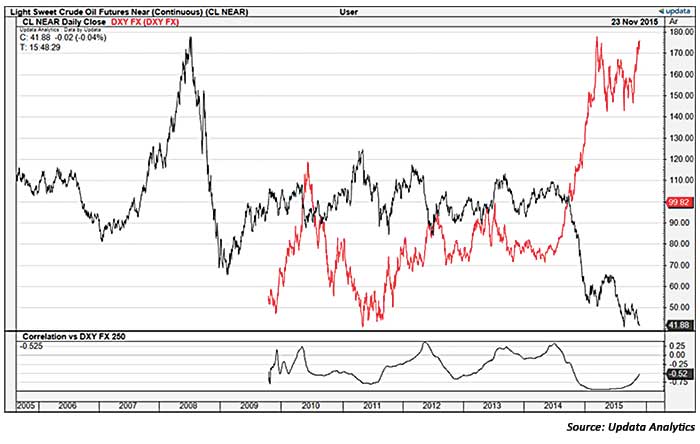
We live in an interconnected world where information is transmitted instantaneously. This lightning-fast transmission impacts asset prices, which react almost as quickly. More than ever before, it is essential to understand how the pieces of the global market work together. The rules of intermarket analysis are not carved in stone but in logic. So, rather than enumerating relationships that may change as the world evolves, we will analyze today’s global markets and derive the rules naturally.
US DOLLAR VS. CRUDE OIL FUTURES PRICE (2005-15)

Today’s U.S. dollar strength is attributable to high U.S. interest rates; remember, much of the rest of the world is paying negative rates. This is negative for commodities priced in U.S. dollars and the earnings of U.S.-based multinationals. This has a deflationary effect—the dollar and bond prices have an inverse relationship. As rates go up and bond prices go down, demand for dollars to purchase these higher rate notes increases and the dollar rallies.
“Safe” government notes, paying higher rates, begin to compete with stocks, which are assumed to be a “riskier” asset. This creates an inverse relationship between dollar strength and the stock market. A lag often occurs in this relationship, and a stock market retreat does not always happen initially. After interest rates increase, the markets can feel a sense of relief and rally. Once reality sets in, and the cost of borrowing rises and the dollar strengthens, cheaper imports may steal sales from American producers. Housing prices initially pick up as buyers lock in rates before they increase, but this effect can be temporary. There is a positive effect for Americans travelling abroad, but weaker foreign tourism in the U.S. and possible effects on the trade balance.
We can certainly see how these relationships are playing out today. Money is flowing into U.S. debt markets, fueled by comparatively high interest rates. U.S. multinationals feel pressure from decreased sales, and employment has stagnated. Mergers and acquisitions in America have increased as companies try to consolidate expenditures. Earnings slow down, hiring stops, and capital-based purchases fall off.
These relationships are not one-to-one but rather form a complex ecosystem. Yes, the rally in the dollar has triggered crude and other commodities to retreat, causing disinflation. However, crude oil is also a victim of oversupply and diminishing demand. Stagnant global economies create decreased industrial demand for energy. Simultaneously, OPEC has employed an agenda to hurt the Russian economy and remove competition from North American oil sands by flooding the market with cheap crude. This has worked.
North American oil companies, burdened by increased debt taken on during times of inflated oil prices and low interest rates, subsequently face potential defaults and have scaled back exploration and drilling operations. This will lead to cheap mergers or even bankruptcies in the oil patch. Sorry, but the U.S. will not be oil independent by 2020. Of course, we know supply and demand reign supreme and decreased production will eventually lead to sharp moves higher in crude prices (we believe by the end of 2016–17).
Real average hourly earnings are down 6.2% from their 1973 peak. Consumer credit is at an all-time high, and discretionary dollars are not available. The economy is not expanding as the FOMC had hoped it would. Intermarket relationships are dynamic, influenced by supply and demand, government policy, and the movements of other asset prices. This is a giant jigsaw puzzle. Joined together, global markets make a picture; alone, they have little meaning.
 Jeanette Schwarz Young, CFP, CMT, CFTe, is the author of the Option Queen Letter, a weekly newsletter issued and published every Sunday, and "The Options Doctor," published by John Wiley & Son in 2007. She was the first director of the CMT program for the CMT Association (formerly Market Technicians Association) and is currently a board member and the vice president of the Americas for the International Federation of Technical Analysts (IFTA). www.optnqueen.com
Jeanette Schwarz Young, CFP, CMT, CFTe, is the author of the Option Queen Letter, a weekly newsletter issued and published every Sunday, and "The Options Doctor," published by John Wiley & Son in 2007. She was the first director of the CMT program for the CMT Association (formerly Market Technicians Association) and is currently a board member and the vice president of the Americas for the International Federation of Technical Analysts (IFTA). www.optnqueen.com
